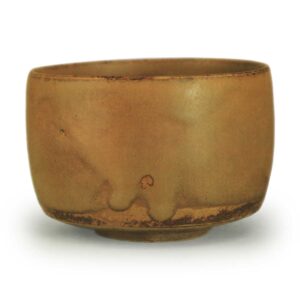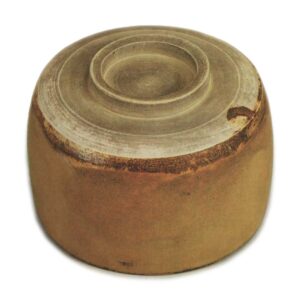

Height: 8.0 – 8.2 cm
Diameter: 11.3 – 11.5 cm
Outer diameter of foot ring: 5.6 cm
Height of foot ring: 0.7 – 0.8 cm
The box inscription reads “Takatori-men tea bowl”, but this refers to the chamfering, as there is a wide chamfer around the waist.
The half-cylindrical shape of the chamfering around the waist of Takatori tea bowls is said to be due to the Enshu-kirigata style, and this tea bowl is therefore known as an Enshu Takatori.
It is a slightly thin, half-cylindrical shape, with a body that is wide at the bottom, and the area below the chamfering at the waist is a clay-colored band, and the foot ring is a neat circle.
The clay is a fine white clay, and the refined and well-balanced style of this piece is completely in keeping with the refined taste of Enshu, and it is a piece that truly brings Enshu’s taste to life. The characteristic yellowish-brown iron glaze of Takatori is applied thickly over the whole piece, and the resulting gradations and irregularities give it a very elegant appearance. Although the shape and glaze may seem monotonous, it is full of a refreshing beauty with a hint of elegance.
The Hakuhata-yama kiln (1620-1665), which was opened in the Chikuzen Takatori kilns after the three old Takatori kilns of Eiman-ji Takuma, Uchi-no-iso and Yamada, was also active during the Enshu period, and it is the kiln where the famous tea caddies favored by Enshu were fired. Judging from the clay and glaze, this tea bowl is also thought to have been made at the Hakuhata-yama kiln. At the Koishiwara kiln of the next period, the ware became very thin, and the glaze became more ornate, but it was not free from a tendency towards frivolity, and a marked gap in the style of production became noticeable.
In general, there are fewer tea bowls than tea caddies and tea scoops made in Takatori. In particular, there are very few tea bowls that can be called true Enshu Takatori, and in that respect, this beveled tea bowl, which also has the solidity of old Satsuma, should be considered a representative work among the few pieces made at the Shirahata-yama Kiln in the Enshu-kirigata style.
In addition, the type of tea bowl called the “Kokotari Hakuzo-te” from ancient times is also thought to be a work of the Enshu Takatori of the Hakuhata-yama kiln, judging from its characteristics. The accessories are
an inner box, paulownia wood, a label on the lid, “Takatori-men tea bowl”
. It is said that it was owned by Kobori Enshu, and was in the possession of the Hyogo Yuki family, but in recent years it was passed on to a certain famous family in Kanto, and it is now in their possession.



